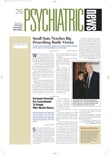Not long ago, Erik Gann, M.D., a San Francisco analyst, had a patient tell him that she had a knife in her purse and might try to kill him with it. Gann quickly thought about what he might use to defend himself and meanwhile tried to keep on analyzing her as coolly as he could.
“I felt as if I was a cross between a Green Beret and analyst,” he confessed at the meeting of the American Psychoanalytic Association in New York City in January, in a session on aggression.
Indeed, what prompted this patient to threaten Gann? What prompts anybody to act in a hostile manner? “Sexuality has been a lot easier to explain as a drive theory than aggression has,” Henri Parens, M.D., a Philadelphia analyst, said at the session.
Nonetheless, there seem to be two kinds of aggression, Parens pointed out. One is a healthy kind—for example, trying to solve a math problem. In fact, a moderate amount of aggression may be beneficial to people’s immune systems (Psychiatric News, November 3, 2000). The other is an unhealthy kind—the expression of hostility. This latter kind can unfortunately start early in life.
“I have seen 12-month-olds already bullying and teasing each other,” Parens said. “I couldn’t believe it.”
However, children certainly don’t have a corner on bullying and other kinds of hostile behaviors, pointed out Stuart Twemlow, M.D., a Topeka, Kan., analyst with a special interest in bullying. Teachers are sometimes bullies as well, he and his colleagues have found.
“There are also bullying doctors, bullying policemen, even bullying reporters and journalists,” Twemlow told Psychiatric News in an interview. “I don’t think there are any more bullies in the teaching profession than there are in other professions, but bullying teachers can have an enormous impact on children. One bullying teacher can cause a lot of misery.”
While the causes of hostile behaviors are undoubtedly complex, sprouting from deep within the human heart, psychiatrists and analysts do appear to be making some progress in identifying some of them. For instance, the desire for control has been identified as one possible cause, revenge as another (Psychiatric News, July 5, 2002).
A third possible cause is envy, Twemlow pointed out. In one study, he and his colleagues found that there is a type of bullying teacher that seems to be envious of bright children and to bully them for that reason.
A fourth possible explanation for hostile behaviors is emotional hurt, both Twemlow and Parens agreed. For instance, teachers who bully students were often bullied themselves in school, just as child abusers were often abused themselves when young, Twemlow and his follow researchers have found. “Anything that we do that hurts another is going to generate hostility in him,” Parens said.
Sometimes the circumstances of life can trigger emotional hurt that in turn drives hostile behavior, another analyst pointed out. This analyst had a patient who learned that his father had cancer. The patient was so upset by the news that, while driving his car, he almost hit a man in a crosswalk. After the patient almost ran over the man in the crosswalk, the man spat at the patient. This patient’s behavior also illustrates how one person’s hostile act can provoke a hostile act by another, and how hostile expression on both sides can quickly escalate into even more. The patient then jumped out of his car and tackled the man.
Reacting in a hostile manner to someone else’s hostile act doesn’t solve anything and only ups the ante, Parens stressed, leading invariably to violence with often tragic consequences. A wiser way to react to another person’s hostile behavior, he indicated, is to keep cool and try to figure out why that person is acting hostile. For example, might emotional pain have sparked his behavior? And if so, what pain? Parens said that he welcomes hostile transference from patients because it indicates that they are hurting inside and prompts him to figure out why.
Handling one’s own hostility rather than someone else’s, of course, is another type of challenge, session participants suggested. Said Parens, “There is nothing wrong in feeling hostile; it is what you do with it.”
One constructive activity, Twemlow suggested during his interview with Psychiatric News, is to channel it into a competitive sport, such as football, basketball, or volleyball. He said that he has been funneling his hostile feelings into the martial arts for 40 years.
If there is any general antidote for hostile behavior in society, however, it is probably altruism—putting other people’s needs before one’s own at times, symposium participants tended to agree. Both child observations and animal studies suggest that altruism may be as fundamental a drive as are sexuality and aggression, Twemlow pointed out.
“We need to not only analyze aggression and deal with it, but encourage altruism,” he asserted. In fact, in a recent study, he and his colleagues found that it is possible to get children who witness acts of bullying to intercede on behalf of the victims.
“In psychoanalysis, we never talk about goodness; we have ignored it,” Parens observed. “But it is a reservoir in all of us that is not tapped enough.” ▪
